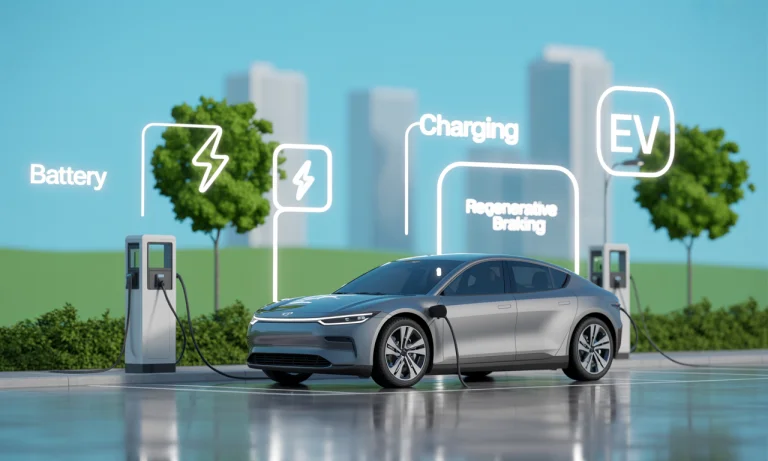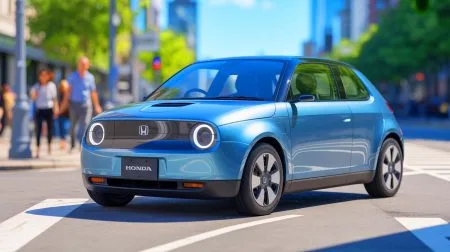For newcomers to electric vehicles, the transition from gasoline-powered engines to battery-driven mobility can feel like stepping into a new universe of terms and technology. The roads are shifting, with companies from Tesla to Volkswagen unveiling innovative models, and drivers are left to decipher acronyms and technical jargon that never appeared on traditional dashboards. Whether you’re considering a Chevrolet Bolt for your daily commute or just want to understand what your neighbor means by “fast charger,” a clear understanding of the evolving EV vocabulary will help you confidently navigate dealership floors, charging stations, and tech news in 2025. Dive into a world where “range anxiety” meets “regenerative braking,” and discover how Nissan and Hyundai are leading the pack with next-generation battery advancements.
EV Vehicle Types Explained: Decoding the New Alphabet Soup
It was at a bustling charging station on the outskirts of London where Maria first confronted the alphabet soup of electric vehicles. Her neighbor spoke of BEVs, HEVs, PHEVs and EREVs as if reciting a grocery list, but each term came weighted with choices about efficiency, range and lifestyle fit. The landscape of EVs is no longer limited to just one type; it’s a dynamic field where the likes of Ford and Kia introduce new concepts every quarter. Battery electric vehicles (BEVs) run solely on electricity—think of models like the Tesla Model 3 or the Volkswagen ID.4, each one carving a space in urban and suburban driveways. Hybrids (HEVs), like Toyota’s long-popular Prius, blend combustion and electric systems for greater efficiency. Plug-in hybrids (PHEVs) go further, offering electric-only short trips, an innovation Chevrolet and BMW have both embraced. Extended range electric vehicles (EREVs) keep an internal combustion engine as a reserve, never directly powering the wheels, a subtle yet crucial distinction for drivers clocking longer distances. Fuel cell electric vehicles (FCEVs), meanwhile, such as some Hyundai and Audi concepts, harness hydrogen for a different approach to zero emissions—signaling a future where even fuel stops might feel unfamiliar. Each classification springs from the same root: how best to balance performance, sustainability, and the realities of infrastructure in a post-petrol world.
| Type | Energy Source | Example Models |
|---|---|---|
| BEV | Battery only (electricity) | Tesla Model 3, Volkswagen ID.4 |
| HEV | Gasoline + small battery | Toyota Prius, Ford Fusion Hybrid |
| PHEV | Gasoline + larger battery (plug-in) | Chevrolet Volt, BMW 330e |
| EREV | Electric, gas only as backup generator | BMW i3 REx |
| FCEV | Hydrogen fuel cell | Hyundai Nexo, Toyota Mirai |
New Metrics: From MPGe to Range Anxiety
Frank, an early adopter of the Lucid Air, smiles at his dashboard’s “MPGe” reading, a figure foreign to many first-time EV drivers. Miles per gallon equivalent (MPGe) provides a familiar yardstick, translating a car’s efficiency into units that echo gasoline’s reign. But the real concern for many is “range anxiety,” that subtle unease about whether a single charge will get you to your destination—be it a day’s commute in a Nissan Leaf or a cross-country excursion in a Ford Mustang Mach-E. Here, numbers like WLTP or NEDC surface, representing evolving standards in how range and emissions are measured, refining expectations for increasingly demanding drivers. For those in city environments, the Neighborhood Electric Vehicle (NEV) offers a glimpse of hyper-local, low-speed commuting, especially popular on university campuses or retirement communities. As infrastructure expands and battery technologies, such as solid-state, emerge, these metrics find new resonance—guiding consumer confidence and reshaping the daily rhythm of car ownership.
Core Components: The Anatomy of an Electric Vehicle
When Alex, a Volkswagen engineer, strips the chassis of an EV, what emerges isn’t a distant cousin of the gasoline car, but something fundamentally new—a puzzle layered from battery cells up to advanced drive units. The motor replaces the conventional engine, spinning silently as it converts electrical pulses into rotary motion. Batteries, typically lithium-ion, serve as this century’s fuel tanks, often tucked beneath seats or across the floor pan for safety and weight distribution—a critical design touch in models like the Audi Q4 e-tron or the Ford F-150 Lightning. The Battery Management System (BMS) orchestrates energy flow, balancing thousands of individual cells to optimize longevity. Add to this the intricacy of the On-board Charger (OBC), inverters, and Low voltage DC-DC converters that help run everything from infotainment screens to heated seats. For brands like Kia and Hyundai, the integration of these advanced systems—sometimes into a compact Electric Power Control Unit (EPCU)—distinguishes the driving experience, enabling whisper-quiet launches and instantaneous torque delivery that traditional engines simply can’t match. Behind the scenes, each part interacts seamlessly, turning electrons into motion, efficiency, and the everyday magic of electric mobility.
| Component | Function | Notable Example/Brand |
|---|---|---|
| Battery Pack | Stores and supplies energy | Hyundai Kona Electric |
| Motor | Converts electricity to movement | Tesla Model S |
| BMS | Manages battery health | Kia EV6 |
| OBC | Manages charging process | BMW i4 |
| Electric Drive Unit | Combines motor and reducer | Chevrolet Bolt |
Why Solid-State Batteries Are the Next Big Leap
Industry insiders talk about solid-state batteries with something close to reverence. Unlike the classic lithium-ion setup, these batteries replace the liquid electrolyte with a solid material, promising substantial gains in safety, size, and energy density. While Volkswagen and BMW are racing to bring solid-state models to market, for now, drivers await the shift with anticipation. If successful, this could mean faster charging, lighter vehicles, and perhaps the end of battery-related range anxiety. It’s a technological arms race, echoing the early days of gasoline versus diesel.
Electric Power and Charging: From Amps to Fast Chargers
Charging an electric vehicle for the first time invites an immediate education in volts, amps, and kilowatt-hours. Jake, overseeing a bustling charging hub in Berlin, recalls early customers’ confusion: “Do I need a Level 2, or is that too much?” he’s asked daily. Level 1 charging, using standard home outlets, is slow but reliable for overnight needs. Regulars at public or workplace stations quickly recognize Level 2 charging’s increased convenience—brands like Audi and Lucid have made use of higher onboard charger capacities to decrease downtime. Level 3, or DC Fast Charging, is the holy grail for road trippers, delivering more than 100 miles of range in the time it takes to finish a coffee at a rest stop. Yet, the conversation doesn’t end there: connector types (Type 1, Type 2, CCS, CHAdeMO) create a web of compatibility that every EV owner must eventually navigate. Tesla’s proprietary Supercharger stations offer a near-seamless experience for the brand’s loyalists, while Nissan and Hyundai drivers enjoy expanding third-party networks. The complexity is undeniable, but so is the freedom—plug in wherever, whenever, and watch the kilometers climb.
| Charging Type | Voltage/Current | Time to Full Charge | Typical Use |
|---|---|---|---|
| Level 1 (Home) | 120V / 8-20A | ~24 hours | Overnight, emergencies |
| Level 2 (Public/Home) | 240V / up to 80A | ~4 hours | Home/work/public stations |
| Level 3 (Rapid) | Up to 900V / 100A+ | ~30 min | Highway, rapid-top-up |
Selecting the Right Connector: Compatibility and Global Standards
Travelers in Europe and North America discover quickly that, unlike traditional fuel pumps, charging connectors are not yet universal. A Nissan LEAF in Tokyo might rely on CHAdeMO, but the same model in Paris prefers Type 2 or CCS Combo 2. Ford’s Mustang Mach-E and BMW’s iX integrate CCS, offering flexibility across regions. Meanwhile, China’s GB/T and upcoming ChaoJi standards point to regional variations—but also a shared desire for global roaming and simplicity. A new generation of “smart charging” points responds seamlessly to vehicle ID, time of day, and grid demand, making the once-complex act of refueling a study in convenience and intelligence.
Under the Hood: The Language of Electricity, Performance, and Control
To grasp the essence of EV power, consider the symphony of electrical principles at play. Watts and kilowatts reveal how much energy is flowing; volts mark the potential, while amps measure the actual stream. Ohms show how much resistance a system faces, critical on winter mornings or in aging batteries. For the tech-inclined, inverters transform a battery’s DC output into the AC required by the drive motor—one reason BMW’s latest lines tout near-instant acceleration. Regenerative braking, an idea championed by Tesla and Audi alike, captures the fleeting energy of a slowing car, topping off your battery with every red light. Meanwhile, torque and horsepower become less abstract: anyone who’s felt the immediate thrust of a Lucid or Kia EV knows there’s a new flavor of excitement in play. But beyond performance lies a story of efficient systems, built by engineers who learned to coax every last mile from each stored kilowatt-hour, revolutionizing what it means to drive.
| Term | Definition | EV Relevance |
|---|---|---|
| kWh (Kilowatt-hour) | Total energy stored in battery | Determines range |
| Torque | Rotational force, measured in Nm | Instant acceleration |
| Regenerative Braking | Energy recovery during slowing | Enhanced efficiency, more range |
| MPGe | Miles per gallon equivalent | Comparing fuel efficiency |
| WLTP | Global standard for range/emissions | Trusted testing benchmark |
Smart Grids, Off-Peak, and the EV Ecosystem
The story of electric vehicles extends well beyond the individual car, touching everything from home energy bills to national grids. Smart charging—where your vehicle’s battery communicates with local utilities—has become more commonplace, especially as off-peak rates offer lower costs for savvy Audi and Hyundai owners. Innovative companies manage not just charging points but energy flows for entire neighborhoods, making every plugged-in EV part of a broader, interconnected energy web. The Open Charge Point Protocols (OCPP, OCPI, OCSP) act as translators, ensuring every car, charger, and provider speaks the same language. As the infrastructure matures, these unsung standards power a revolution invisible to most but essential to all.
Common Questions on EV Jargon, Range, and Everyday Use
What’s the difference between kilowatt (kW) and kilowatt-hour (kWh) when talking about EVs?
Kilowatt (kW) measures power—the rate at which energy is used or generated—while kilowatt-hour (kWh) measures energy over time. Think of kW as how fast water is coming out of a tap, and kWh as the total amount of water collected in a bucket. In EVs, kW affects charging speed; kWh represents battery capacity and total range.
Why do some EVs use different charging plugs—can’t all cars use the same connector?
Not yet. Connector types depend on region, manufacturer, and charging speed. Tesla has its own plug for Superchargers, while Nissan might use CHAdeMO and most modern Ford or Volkswagen models use the CCS standard in Europe and North America. Industry efforts are ongoing to simplify this.
What is “range anxiety” and is it still a problem?
“Range anxiety” describes the fear of running out of charge mid-journey. Today, with improved battery capacities (like those in the Lucid Air or Kia EV9) and a growing fast-charging network, it’s less common—especially for drivers who plan their routes and use smart systems to monitor availability.
How does regenerative braking work and do all EVs have it?
Regenerative braking captures energy when the car slows down and directs it back into the battery. Nearly all major EVs, including models from Tesla, BMW, and Hyundai, use this technology, boosting range and efficiency.
Are solid-state batteries available now in mainstream EVs?
Not yet widely. In 2025, advanced prototypes are being tested by Volkswagen, BMW, and others, but mainstream use is still on the horizon. They promise greater safety, faster charging, and even longer range in the future.
Did you like it? 4.5/5 (25)







